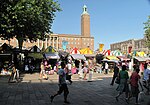Norwich Market (also known as Norwich Provision Market) is an outdoor market consisting of around 200 stalls in central Norwich, England. Founded in the latter part of the 11th century to supply Norman merchants and settlers moving to the area following the Norman conquest of England, it replaced an earlier market a short distance away. It has been in operation on the present site for over 900 years.
By the 14th century, Norwich was one of the largest and most prosperous cities in England, and Norwich Market was a major trading hub. Control of, and income from, the market was ceded by the monarchy to the city of Norwich in 1341, from which time it provided a significant source of income for the local council. Freed from royal control, the market was reorganised to benefit the city as much as possible. Norwich and the surrounding region were devastated by plague and famine in the latter half of the 14th century, with the population falling by over 50%. Following the plague years, Norwich came under the control of local merchants and the economy was rebuilt. In the early 15th century, a Guildhall was built next to the market to serve as a centre for local government and law enforcement. The largest surviving mediaeval civic building in Britain outside London, it remained the seat of local government until 1938 and in use as a law court until 1985.
In the Georgian era, Norwich became an increasingly popular destination with travellers and developed into a fashionable shopping town. Buildings around the market were developed into luxury shops and coaching inns. The eastern side of the market was particularly fashionable and became known as Gentleman's Walk. The area around the market had become very congested by the 19th century, but the council was unable to raise funds for improvement and few alterations were made. Because many of the market's stalls were privately owned, the council was unable to rearrange the market into a more rational layout.
Following the First World War, the local authority began to systematically buy up all the stalls on the market, eventually bringing the entire market into public ownership. It was radically redesigned in the 1930s: stalls were arranged into parallel rows and a new City Hall was built along the entire western side of the marketplace to replace the by then inadequate Guildhall. This new arrangement survived with few significant changes for the rest of the 20th century. By the 1990s, the market was becoming decrepit and, in 2003, proposals were made for another radical rebuilding of the area. These proposals were extremely controversial and were abandoned in 2004 in favour of a scheme which retained the parallel rows of stalls, but replaced the old stalls with steel units of four stalls each. The rebuilt market was completed in early 2006 and is one of the largest markets in Britain.











